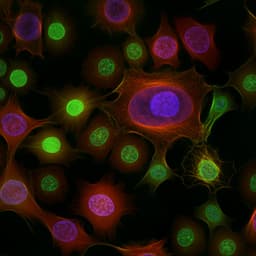
Medicine and Health
Socio-economic and ethnic disparities in childhood cancer survival, Yorkshire, UK
K. J. Cromie, N. F. Hughes, et al.
This groundbreaking study reveals the stark socio-economic and ethnic disparities in childhood cancer survival rates across Yorkshire, examining 20 years of data. Researchers found that deprivation significantly impacts survival odds, especially for leukemia and lymphoma, with South Asian children facing notable challenges. Conducted by K. J. Cromie and colleagues, this work highlights the urgent need for targeted interventions to ensure equitable healthcare outcomes for all children.
~3 min • Beginner • English
Introduction
UK paediatric cancer survival exceeds 84% for diagnoses under age 15, but gains are heterogeneous across tumour groups and populations. Socio-economic gradients in child health outcomes are well documented, and adult cancer survival shows poorer outcomes in more deprived areas. Prior UK studies report socio-economic and ethnic inequalities in childhood cancers, notably an increased mortality risk among more deprived children with acute lymphoblastic leukaemia (ALL) and higher mortality among south Asian children for ALL and lymphoma in earlier periods. However, few studies have assessed how these disparities have evolved over time. In Yorkshire and the Humber, with a sizable, relatively homogeneous south Asian population, this study investigates temporal trends (1997–2016) in socio-economic and ethnic disparities in childhood cancer survival using high-quality, population-based data and validated ethnicity assignment.
Literature Review
Previous UK and regional studies have shown: (1) socio-economic inequalities in adult cancer survival, (2) increased mortality among socio-economically deprived children with ALL (e.g., up to 86% increased risk before 2010), and (3) ethnic disparities, including worse ALL survival for south Asian children (1981–1996) and approximately twofold increased mortality in south Asian children with lymphoma up to 2005. National, systematic estimates over extended timeframes are lacking, and most prior work has not examined temporal change in the joint or independent effects of socio-economic status and ethnicity on survival. The Yorkshire region’s demography enables more detailed assessment within a south Asian population. This study addresses these gaps by providing time-stratified analyses with attention to structural confounding between ethnicity and deprivation.
Methodology
Design and data source: Population-based cohort from the Yorkshire Specialist Register of Cancer in Children and Young People (YSRCCYP), including all children aged 0–14 years resident in Yorkshire & the Humber, diagnosed with malignancy or borderline/benign CNS tumours (ICCC-coded) from 1997–2016. Follow-up to 31 Dec 2020 with proactive biennial vital status checks; death-certificate-only cases excluded (n=14). For multiple primaries (n=40), first tumour used. Cohort size: 2674. Diagnostic grouping: ICCC-3 categories collapsed into four groups: leukaemia (I), lymphoma (II), CNS tumours (III), and other solid tumours (IV–XII). Stage/grade proxies: leukaemia stage via white blood cell count; lymphoma stage via Ann Arbor; CNS tumours by WHO grade (low I–II vs high III–VI); other solid tumours by TNM. Ethnicity assignment: Primary from Hospital Episode Statistics (HES) using 1991/2001 Census categories; if missing (n=174), Onomap naming algorithms used. Random clinician validation on a subset (n=40). Ethnic groups for analysis: south Asian (Pakistani, Indian, Bangladeshi) vs non-south Asian (White and Other including Black, Chinese, other Asian). Deprivation exposure: Townsend deprivation index (unemployment, non-home ownership, overcrowding, non-car ownership) assigned using validated postcode at diagnosis mapped to LSOA and Census year corresponding to diagnosis period (1991 for 1997–2000; 2001 for 2001–2010; 2011 for 2011–2016). Analyzed as population-weighted fifths (I least to V most deprived) and as a continuous score in regression. Statistical analysis: Kaplan–Meier estimates of crude 5-year survival by ethnic group and deprivation fifths. Time stratification: For all cancers combined, 5-year periods (1997–2001, 2002–2006, 2007–2011, 2012–2016); for diagnostic groups, 10-year periods (1997–2006, 2007–2016) due to smaller numbers. Multivariable Cox regression models estimated the association between increasing area-based deprivation (continuous Townsend) and mortality risk over time. Due to structural confounding (south Asian children predominantly residing in more deprived areas), models interpreted the deprivation coefficient as capturing the joint effect of area deprivation and ethnicity at diagnosis. Goodness-of-fit via BIC supported linear functional form for deprivation. Models re-parameterized to estimate period-specific effects (HR per unit Townsend) for each time stratum; lymphomas modeled in 10-year periods. Adjustment set: Minimal sufficient adjustment informed by DAGs (DAGitty v3.0), including ethnic group (south Asian, White, Other), sex, age at diagnosis (time-dependent where needed), relapse (time-dependent), ICCC-3 subgroup, disease stage/grade, and principal treatment centre (PTC) where applicable (not included for leukaemia/lymphoma due to standardized care). Missing data handling: Stage/grade missingness (leukaemia 5.7%; lymphoma 42.2%; CNS 3.3%; other solid tumours 75.0%) imputed assuming missing at random using ordered logistic regression with 50 multiply imputed datasets per group. Imputation models included all covariates, treatment modalities (surgery, radiotherapy, chemotherapy) as binaries, Nelson–Aalen cumulative hazard estimate, and death indicator. Proportional hazards checked via Schoenfeld residuals; age included as time-dependent in models where PH violated (all cancers combined, lymphomas, other solids). Model discrimination assessed by c-index; Monte Carlo standard errors reported. Sensitivity analyses: complete case vs imputed, and models with 'unknown' categories for missing covariates; results directionally consistent. Additional sensitivity: separate models for ALL vs all leukaemias; high- vs low-grade CNS tumours. Software: Stata 16 with multiple imputation by chained equations.
Key Findings
- Cohort profile: 2674 children; 85.8% White, 8.7% south Asian, 5.6% other ethnicities. South Asian children had substantially higher deprivation (median Townsend 4.9, IQR 2.1–6.8) than non-south Asian (median −0.2, IQR −2.5–3.3); 68.2% of south Asian children were in the most deprived fifth vs 25.6% of non-south Asian. - All cancers combined (Cox models, HR per unit Townsend): 1997–2001 HR 1.05 (1.00–1.09) indicating higher mortality with increasing deprivation; no notable socio-economic differences from 2002 onwards (2002–2006 HR 1.00 (0.95–1.06); 2007–2011 HR 1.02 (0.97–1.07); 2012–2016 HR 1.00 (0.96–1.07)). - Leukaemia: Strong socio-economic disparity early, attenuating over time. 1997–2001 HR 1.11 (1.03–1.20). For ALL specifically, 1997–2001 HR 1.17 (1.07–1.28). Deprivation associated with reduced risk between 2002–2011 (HR ~0.94–0.95), with greater variability 2012–2016 HR 1.04 (0.94–1.14); ALL 2012–2016 HR 0.97 (0.86–1.09). Crude survival: 1997–2006 leukaemia 5-year survival least deprived I 89.5% vs most deprived V 76.5%; by 2007–2016 convergence with higher survival in more deprived groups (IV 90.0%, V 87.0%) vs I 86.7%, II 82.5%. Ethnicity: 1997–2006 south Asian 72.2% vs non-south Asian 87.2%; 2007–2016 south Asian 87.0% vs non-south Asian 86.4%. - Lymphoma: Persistent ethnic disparity. 1997–2006 crude 5-year survival non-south Asian 87.2% vs south Asian 72.2%; 2007–2016 a 15% gap remained. For non-Hodgkin lymphoma (NHL), 2007–2016 crude 5-year survival nearly 35% higher in non-south Asians than south Asians. Cox models did not show clear socio-economic gradients across periods. - CNS tumours: Socio-economic disparities persisted up to 2011. Cox HR per Townsend: 1997–2001 HR 1.02 (0.95–1.01); 2002–2006 HR 1.07 (0.98–1.16); 2007–2011 HR 1.08 (1.00–1.16); 2012–2016 HR 0.96 (0.88–1.15). Ethnicity: 1997–2006 south Asian 60.0% vs non-south Asian 71.6%; 2007–2016 south Asian 63.9% vs non-south Asian 78.8%. - Other solid tumours: Early socio-economic disadvantage observed (1997–2001 HR 1.04 (0.97–1.12)), with survival advantages in less deprived areas persisting into 2012–2016 (HR 1.07 (0.98–1.16)). Ethnicity: 1997–2006 south Asian higher survival (79.3%) than non-south Asian (71.7%); by 2007–2016 difference narrowed (south Asian 81.8% vs non-south Asian 80.6%). - Care patterns: 89–90% received care at a principal treatment centre; care standardized across centres with trial enrolment and guidelines. - Overall trend: Long-term survival improved across the 20-year period, with the largest gains among south Asian children and those in the most deprived areas for leukaemia; nevertheless, inequalities remained, notably for CNS tumours (by deprivation) and lymphomas (by ethnicity).
Discussion
The study demonstrates that, despite universal healthcare access in the UK, socio-economic and ethnic inequalities in childhood cancer survival exist and have evolved heterogeneously over time. For leukaemia, early-period disparities by deprivation and ethnicity diminished markedly after 2002, with convergence of 5-year survival between south Asian and non-south Asian children and between deprivation groups. Potential explanations include advances in treatment protocols, supportive care, and possibly genetic factors affecting ALL subtypes and prognosis (e.g., higher prevalence of favorable DUX4-rearranged subtypes in south-east Asian ancestry). In contrast, lymphoma showed persistent ethnic disparities with worse outcomes among south Asian children, particularly for NHL, suggesting roles for biological differences, treatment response/adherence, infection susceptibility, or unmeasured social factors. CNS tumours exhibited sustained socio-economic disparities up to 2011 even after adjusting for stage/grade and subtype, indicating that non-biological factors (timely access, pathway delays, supportive resources) may influence outcomes, though biological heterogeneity may also contribute. Structural confounding between ethnicity and deprivation limited causal decomposition of ethnicity’s direct effect; thus, deprivation coefficients were interpreted as capturing the joint ethnicity–deprivation context at diagnosis. Standardized specialist care across centres reduces the likelihood that treatment site differences explain disparities. The findings emphasize the importance of incorporating ethnicity and deprivation in national analyses to identify and address inequities and to tailor resource allocation and interventions to at-risk groups.
Conclusion
This population-based study from Yorkshire provides a comprehensive, time-stratified assessment of socio-economic and ethnic inequalities in childhood cancer survival over two decades. While overall survival improved, large early disparities in leukaemia diminished post-2002, whereas ethnic disparities in lymphoma and socio-economic disparities in CNS tumours persisted into the 2010s. The work underscores the need for national cancer registration and analytic services to routinely report outcomes by ethnicity and deprivation, and for targeted strategies to mitigate inequities. Future research should: (1) integrate genomic and ancestry data to elucidate biological contributors to disparities; (2) use linked mortality data to analyze causes and timing of death across groups; (3) refine socio-economic measurement with individual-level SES; (4) extend analyses to older teens and young adults; and (5) explore pathway factors such as diagnosis intervals, adherence, and supportive care access.
Limitations
- Age range limited to 0–14 years; outcomes for 15–16-year-olds in paediatric care not included. - Small number of south Asian cases constrained statistical power, necessitating binary ethnic categorization and limiting subgroup analyses (e.g., Pakistani vs Indian; Black populations). - Structural confounding between ethnicity and area deprivation prevented estimation of ethnicity’s direct causal effect. - Lower event counts in recent periods may reduce power to detect disparities. - High missingness in stage/grade for some groups (notably 75% in other solid tumours); imputation assumed missing at random, which may not fully hold given site/tumour variation, risking bias. - Heterogeneity across tumour types means all-cancers-combined models should be interpreted cautiously. - Potential residual confounding despite DAG-informed adjustment.
Related Publications
Explore these studies to deepen your understanding of the subject.







